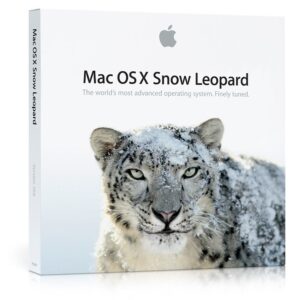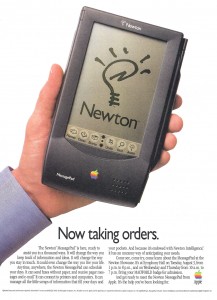Apple
iPhone 4 Goes on Sale
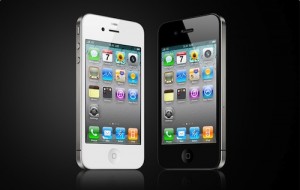
After a wild lead-up involving a prototype being lost at a bar, Apple’s iPhone 4 officially went on sale. Later the iPhone 4 would then become the subject of the Antennagate controversy. With so much attention given to the phone, it really was no wonder that it went on to set sales records.
Apple Announces Snow Leopard
At their World Wide Developers Conference in San Francisco, Apple announced their next Mac operating system, Mac OS X 10.6, known as Snow Leopard. Snow Leopard, the follow up to Mac OS X 10.5 Leopard, was as the name somewhat insinuated, more of an update to the previous OS than a full blown feature upgrade. Indeed many of the features in Snow Leopard were performance updates and optimizations for 64-bit and mutli-core processors. It was also the first Mac OS to drop support for the PowerPC processor line, focusing only on the Intel processor, which Apple has switched to for their Macintosh computers in 2006. Additionally the footprint of the OS was actually smaller, which would save disk space for users of Snow Leopard when it was released in September of that year.
The Mac Gets Intel Inside
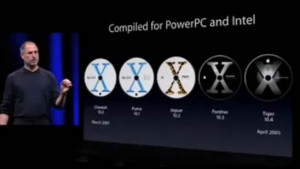
In a keynote address at Apple’s Worldwide Developers Conference, Steve Jobs announces that Macintosh computers will transition from PowerPC to Intel processors and demonstrates Mac OS X running on a computer with an Intel Pentium 4 processor. Jobs revealed at the time that Apple had been secretly preparing for a possible transition to Intel for many years. Unbeknownst to the public, for every version of Mac OS X released, Apple actually had prepared a version running on an Intel processor. By making the transition to Intel, Apple paved the way for the resurgence of the Macintosh computer by making it more compatible with software for Microsoft Windows.
The Apple II Enters the Market
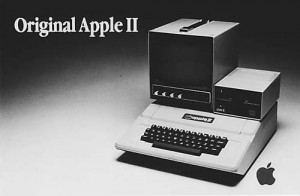
The original Apple II computer goes on sale. The Apple II featured an a 1MHz MOS 6502 processor, an integrated keyboard, a built-in BASIC programming environment, expandable memory (4K expandable to 48K), a monitor capable of color graphics, a sound card, and eight expansion slots. To include all these features in one discrete unit was highly innovative and the reason it is considered the first practical personal computer. However, in the spirit of the original computer hacker, the Apple II was also available as a circuit-board only, without keyboard, power supply, or case. A couple of years later, the combination of the Apple II series and the first “killer app” of the business world, the VisiCalc spreadsheet program, popularizes personal computers among business users. This sudden success of the “home computer” in the business world surprises established technology companies and eventually leads IBM to scramble to develop their IBM PC.
Apple Newton Announced
May 29, 1992
At the Consumer Electronics Show (CES) in Chicago, Apple Computer CEO John Sculley first announces the coming release of the Newton personal digital assistant to a group of reporters, explaining that the Newton “is nothing less than a revolution.” Although there was not a fully functioning prototype available, the Newton technology is demonstrated, including how to order a pizza by moving topping icons onto a pie and then faxing the order from the device.
The Newton is Apple’s first major new product line since the Macintosh was released eight years earlier. The Newton unveiling generates immediate buzz, but due to several factors, Sculley’s announcement will ultimately be considered a major mistake. The announcement itself tipped the company’s hand to its competitors and wildly inflated consumer expectations. The Newton’s release was delayed until August of 1993, and when it was released, it was not as user-friendly as expected. Specifically, the core hand-writing recognition feature was widely criticized as buggy and inaccurate. While the technology was greatly improved in subsequent revisions, the Newton never gained much commercial success, and shortly after his return Steve Jobs discontinued the Newton in 1998.
Apple Cube Store Opens in NYC
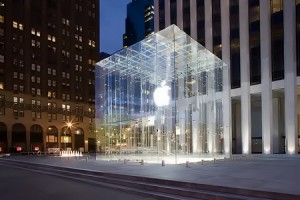
Apple opens their second store in New York City, a 20,000 square-foot shop at the underground concourse of the General Motors building at 767 Fifth Avenue. Open 24-hours a day, the shop is visible at street level through a 32-foot glass cube. Designed by Apple’s CEO Steve Jobs at a cost of $9 million, people stood in line for hours prior to the store’s opening.
Apple Debuts Retail Stores
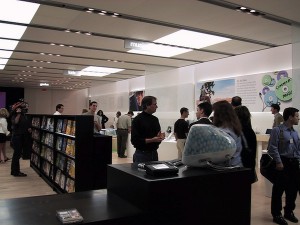
Apple Computer opens the first two locations of their new retail stores in McLean, Virginia and Washington, D.C. In the first weekend of opening, the stores will attract 7,700 shoppers and will sell a combined $599,000. While ridiculed by many technology “experts” at the time, the Apple Stores have been insanely successful and was one of the key reasons for Apple’s resurgence in the 2000’s.
Apple III Introduced
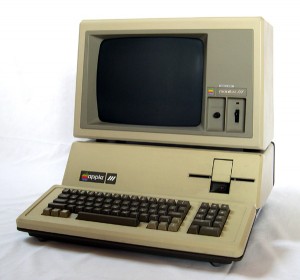
At the National Computer Conference in Anaheim, California, Apple Computer introduces the Apple III. It is the company’s first attempt at a business computer, its first departure from the Apple II architecture, and it will also become Apple’s first real failure. Apple expects the Apple III to be released in July, but in one of the worst cases of delay in tech history, the system wouldn’t reach stores until January. Once released, the Apple III will be plagued by component failures that would ultimately lead to large recalls. The Apple III never recovered from it’s original negative reception and was discontinued by Apple in 1984
Apple Retail Stores Revealed
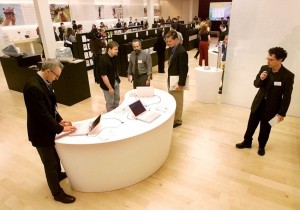
Apple Computer announces plans to operate a chain of retail stores, opening twenty-five retail stores in the United States by the end of the year. Steve Jobs holds a commemorative press event at Apple’s first store in the second level of Tysons Corner Center to make the announcement. The store, along with a second location in Washington, D.C. will open on Saturday, May 19. At the time, Apple’s plan was generally derided by technology “experts” as doomed to failure. On this, their anniversary date, Apple’s retail stores are now considered one of the catalysts to Apple’s tremendous growth.
System 7 Released
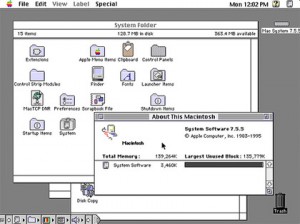
The System 7 operating system for the Macintosh is released, the second major upgrade to the Mac OS since 1984. One of the major features included in System 7 is built-in cooperative multitasking. System 7 also introduces the concept of “aliases”, which will later be copied as “shortcuts” in Microsoft Windows 95. System 7 was the first Mac OS that I personally became familiar with, and it was the foundation of future Mac OS versions until the release of Mac OS X almost exactly 10 years later.

